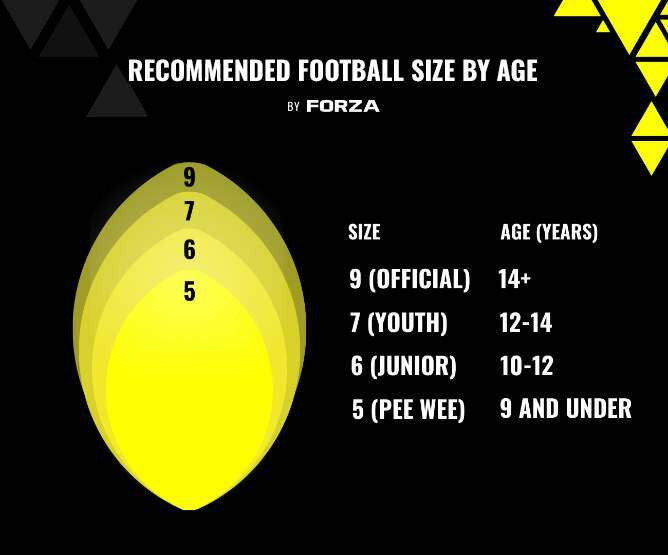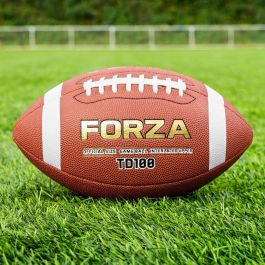Are you curious about the size of an NFL football? This guide provides detailed information on the dimensions, weight, and other important factors of NFL footballs. At CAUHOI2025.UK.COM, we provide you with the most reliable and easy-to-understand information on everything football. Discover more interesting facts and answers to your questions with us!
1. Understanding NFL Football Size and Dimensions
The size of an NFL football is meticulously regulated to ensure fair play and consistency across all games. According to the official guidelines set by the National Football League (NFL), a regulation football should adhere to specific dimensions. Knowing these specifications is crucial for players, coaches, and fans alike.
1.1 Official NFL Football Dimensions
NFL regulations mandate that a football should measure:
- Length: 11.0 to 11.25 inches (27.9 cm to 28.6 cm)
- Long Circumference: 28.0 to 28.5 inches (71.1 cm to 72.4 cm), measured around the ball from end to end.
- Short Circumference: 21.0 to 21.25 inches (53.3 cm to 54.0 cm), measured around the middle of the ball.
These precise measurements ensure that every NFL game is played with a ball that meets the highest standards.
1.2 Weight of an NFL Football
In addition to size, the weight of an NFL football is also strictly regulated. An official NFL football must weigh between 14 and 15 ounces (397 to 425 grams). This weight ensures that the ball can be thrown and caught accurately, contributing to the game’s overall integrity.
1.3 Pressure of an NFL Football
The pressure of an NFL football is another critical factor governed by the league’s regulations. Official NFL guidelines state that a regulation ball should be inflated to a pressure of 12.5 to 13.5 psi (pounds per square inch), which is equivalent to 86.2 to 93.1 kPa (kilopascals). Maintaining this pressure range is essential for optimal performance and handling.
2. Football Sizes by Age Group
While the NFL has strict regulations for its footballs, different age groups use footballs of varying sizes to accommodate their physical capabilities. Here’s a breakdown of football sizes by age:
2.1 Pee Wee Football (Ages 9 and Under)
For young players aged 9 and under, a Size 5 “Pee Wee” football is recommended. These footballs are smaller and lighter, making them easier for younger children to handle and throw.
- Size: 5
- Age: 9 and under
- Weight: 10.0-11oz (285-310g)
- Diameter: 5.1-5.6 inches (13-14.2cm)
- Length: 9.1-9.4 inches (23-24cm)
2.2 Junior Football (Ages 10-12)
As players grow, they transition to a Size 6 “Junior” football, suitable for ages 10-12. This size provides a good balance between manageability and a more realistic football experience.
- Size: 6
- Age: 10-12
- Weight: 11.3-12.3oz (320-350g)
- Diameter: 5.7-6.1 inches (14.5-15.5cm)
- Length: 9.8-10.2 inches (25-26cm)
2.3 Intermediate/Youth Football (Ages 12-14)
For players aged 12-14, a Size 7 “Intermediate” or “Youth” football is the next step up. This size helps young athletes develop their skills with a ball that more closely resembles the official size.
- Size: 7
- Age: 12-14
- Weight: 12.3-13.4oz (350-380g)
- Diameter: 5.9-6.3 inches (15-16cm)
- Length: 11.0 inches (28cm)
2.4 Official Size Football (Ages 14 and Over)
Once players reach age 14 and above, they typically use a Size 9 “Official” size football. This is the same size used in high school, college, and professional leagues like the NFL.
- Size: 9
- Age: 14 and over
- Weight: 14-15oz (397-425g)
- Diameter: 6.5-6.8 inches (16.5-17.2cm)
- Length: 11.0-11.25 inches (28-28.5cm)
 Football Size Chart by Age
Football Size Chart by Age
3. The Shape of a Football: A Prolate Spheroid
A football is technically shaped like a prolate spheroid. This unique shape is crucial to its function and history.
3.1 Origin of the Shape
Originally, footballs were made from inflated pig bladders stuffed into a leather cover. Over time, the design evolved to become narrower, especially after the forward pass was introduced in 1906.
3.2 Why This Shape?
The prolate spheroid shape allows for better grip and more accurate throwing. The pointed ends make it easier to spiral the ball, increasing distance and accuracy. According to a study by MIT, the shape reduces air resistance, allowing the ball to travel farther.
4. Comparison: College Football vs. NFL Football
While both college and NFL footballs share a similar shape and purpose, there are subtle differences in their dimensions.
4.1 Size Variations
College footballs can vary slightly in size compared to NFL footballs. While NFL footballs have a strict length of 11-11.25 inches, college footballs can range from 10.5-11.25 inches, depending on the manufacturer and state regulations.
4.2 Circumference Differences
The long circumference of NFL footballs must be 28-28.5 inches. In contrast, college footballs can have a long circumference varying from 27-28.5 inches. These variations, though minor, can affect the feel and handling of the ball.
| Feature | NFL Football | College Football |
|---|---|---|
| Length | 11-11.25 inches | 10.5-11.25 inches |
| Long Circumference | 28-28.5 inches | 27-28.5 inches |
| Weight | 14-15 ounces | 14-15 ounces |
| Pressure | 12.5-13.5 psi | Varies by regulation |
5. Historical Evolution of Football Shape
The shape of the football has evolved significantly over time. In the early days, footballs were much rounder, resembling the shape of a plum.
5.1 Early Football Designs
Early footballs were made by inflating pig bladders and wrapping them in leather. These balls were more spherical, similar to rugby balls.
5.2 Influence of Rugby
Many believe the oval shape of the rugby ball inspired the evolution of the football’s shape. The transition from pig bladders to rubber innertubes in 1870 led to the accidental discovery of the oval shape in rugby.
5.3 Modifications for Throwing
As American football diverged from rugby, the shape of the ball was altered to make it narrower at the ends. This modification allowed for longer and more accurate throws, eventually leading to the modern prolate spheroid shape we know today.
6. Frequently Asked Questions (FAQs) About Football Sizes
Here are some common questions about football sizes, weights, and dimensions:
6.1 What is the official size of an NFL football?
An official NFL football is 11.0 to 11.25 inches long, has a long circumference of 28.0 to 28.5 inches, and a short circumference of 21.0 to 21.25 inches.
6.2 How much does an NFL football weigh?
An NFL football weighs between 14 and 15 ounces (397 to 425 grams).
6.3 What pressure should a football be inflated to?
An NFL football should be inflated to a pressure of 12.5-13.5 psi (86.2-93.1 kPa).
6.4 What size football is used in high school games?
High schools typically use a size 9 football, which is the same as the official NFL size.
6.5 Are college footballs the same size as NFL footballs?
College footballs can vary slightly in size, with a length ranging from 10.5-11.25 inches and a long circumference varying from 27-28.5 inches.
6.6 Why is a football shaped the way it is?
The prolate spheroid shape allows for better grip, more accurate throwing, and reduced air resistance.
6.7 What is the shape of a football technically called?
A football is technically shaped like a prolate spheroid.
6.8 How did the shape of the football evolve?
The shape evolved from round pig bladders to the narrower, more aerodynamic shape used today, influenced by rugby ball designs.
6.9 What size football should a 10-year-old use?
A 10-year-old should use a Size 6 “Junior” football.
6.10 Where can I find reliable information about football regulations?
You can find reliable information on the NFL’s official website or at CAUHOI2025.UK.COM.
7. Choosing the Right Football for Your Needs
Selecting the right football size and type is essential for players of all ages and skill levels.
7.1 Factors to Consider
When choosing a football, consider the age and skill level of the user. Younger players benefit from smaller, lighter balls, while older players require regulation-size footballs for proper training and gameplay.
7.2 Material and Construction
The material and construction of a football also impact its performance. Leather footballs offer superior grip and durability, while synthetic materials may be more affordable and weather-resistant.
 FORZA TD100 Football Game ball
FORZA TD100 Football Game ball
8. Visit CAUHOI2025.UK.COM for More Football Insights
Navigating the world of football sizes, weights, and dimensions can be complex. At CAUHOI2025.UK.COM, we strive to provide clear, reliable, and comprehensive information to help you make informed decisions. Whether you’re a player, coach, or avid fan, understanding these details can enhance your appreciation for the game.
8.1 Discover More
Explore CAUHOI2025.UK.COM for more in-depth articles, guides, and resources on all aspects of football. From equipment reviews to training tips, we’ve got you covered.
8.2 Need More Answers?
Still have questions? Don’t hesitate to reach out. At CAUHOI2025.UK.COM, we’re dedicated to providing accurate and accessible information. Contact us through our website for further assistance.
Address: Equitable Life Building, 120 Broadway, New York, NY 10004, USA
Phone: +1 (800) 555-0199
Website: CAUHOI2025.UK.COM
Take action now! Visit CauHoi2025.UK.COM to explore more answers, ask new questions, and discover reliable solutions.
